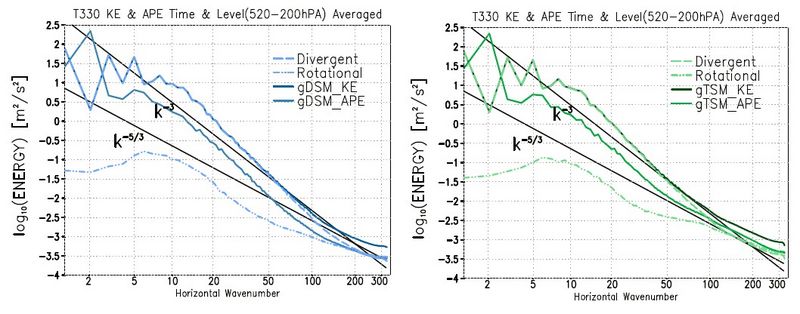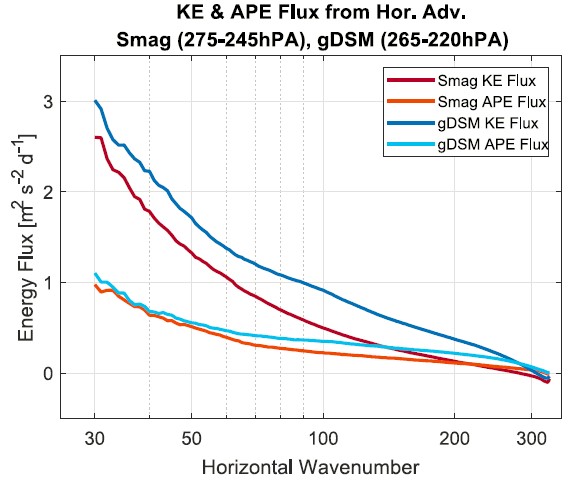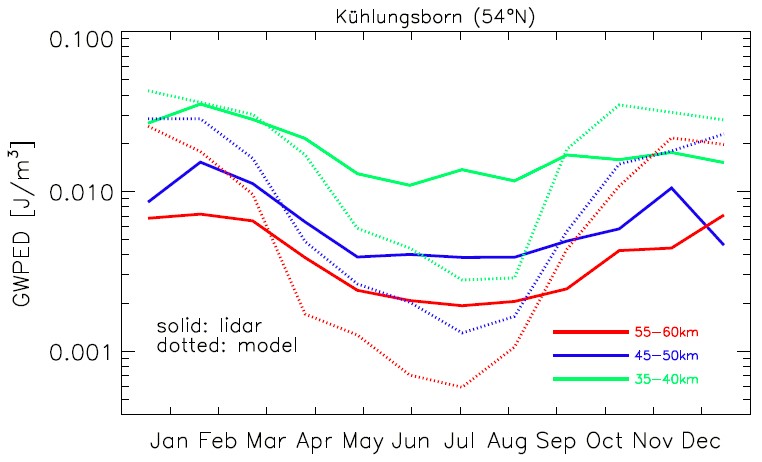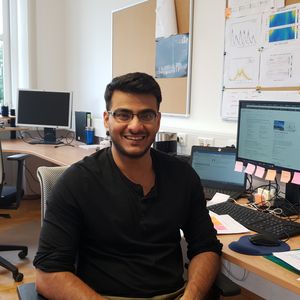T1: Mesoscale energy cascades in the lower and middle atmosphere
Principal investigators: Prof. Erich Becker (Leibniz Institute of Atmospheric Research), Dr. Almut Gassmann (Leibniz Institute of Atmospheric Research), Prof. Franz-Josef Lübken (Leibniz Institute of Atmospheric Research)
Objectives
This project aims to develop a closure scheme for the atmospheric flow that is suitable for numerical truncation in the regime of stratified macro-turbulence. Particular emphasis is spent on conservation laws and scale invariance. High-resolution lidar and radar measurements of temperatures and winds, as well as retrievals from other methods, are used to construct horizontal and vertical wavenumber power spectra for the upper troposphere and the mesosphere, and to validate the model results.
Overview
High-resolution numerical models of the atmospheric circulation have a numerical truncation around 60 km, so that in contrast to climate models with lower resolution, a significant part of the gravity waves (GWs) in this regime of the so-called stratified macro-turbulence is already resolved in the model. Only the fluctuations smaller than 60 km in the "sub-grid" scales (SGS) are not represented in the model. However, since in reality the energy transfer in the direction of the viscous scales is also continued through the SGS, the numerical model must mimic the effects of this cascade as the macro-turbulent motions approach the resolution scale. This requires a "closure" of the cascade in the form of a parameterization of the mesoscale SGS dynamics.
The main objective of this project was to advance such a turbulence parameterization based on the Smagorinsky or mixing-length model. Before the beginning of the CRC, a dynamic Smagorinsky model (in which the mixing length is estimated from the resolved wind fields, DSM) existed only for horizontal momentum diffusion. Particular emphasis was spent to be consistent with the conservation laws and scale invariance. The scheme has been implemented in a global and a regional circulation model and was analyzed regarding the spectral budgets of kinetic and available potential energy in order to study the modeled processes of energy transfer in detail. High-resolution lidar and radar measurements of temperatures and winds in the mesosphere were used for model validation in the middle atmosphere.
Main Results
Implementation and validation of the generalized Dynamic Smagorinsky Model for momentum and sensible heat equations in KMCM
For the first time, a mathematically consistent scale-invariant mixing length for both momentum and sensible heat for horizontal and vertical diffusion in highly resolved atmosphere models were derived. Hence, the assumption of a constant Prandtl number (the ratio of momentum and sensible heat diffusion) could be relaxed (see Fig. 1).

In addition, the spectral fluxes in mesoscales were analyzed to investigate whether the scaling laws of stratified macroturbulence are valid for different altitude ranges of the atmosphere. In particular, a turbulent energy cascade should be well simulated as it is observed around the tropopause region. Stratified turbulence predicts a forward cascade of kinetic energy (KE) and available potential energy (APE) for stratified rotating fluids.

Energy Cascades in ICON-IAP
The ICON-IAP model is, in contrast to the spectral KMCM, a non-hydrostatic circulation model based on a hexagonal C-grid on the sphere and adjustable to any regional geometry. One goal of this project was to prepare the ICON-IAP model for the implementation of the DSM for momentum diffusion. Major challenges that were solved in this regard were to formulate a correct momentum diffusion tensor on the hexagonal C-grid and to overcome numerical problems that would call for additional smoothing. The two mentioned achievements raise the numerics on hexagonal C-grids to a comparative level of known and widely used quadrilateral C-grids.
In addition, to improve the necessary understanding of all important processes relevant to the energy cycle and the interaction of the different dynamic regimes, it is important to know which processes do not contribute to atmospheric processes. Therefore, a transformation of the governing equations has been introduced so that processes that do not contribute are made invisible. Therefore, only net forcing terms remain in the momentum equations. Comparing the spectral budgets of the kinetic and the available potential energy obtained from the transformed and the untransformed sets of equations, it is shown that horizontal and vertical contributions can be better disentangled with the transformed set of equations, so that the forward energy cascade is clearly unveiled.
Lidar Measurements
At IAP daylight capable lidars (LIght Detection And Ranging) have been developed which measure temperatures and winds simultaneously during night and day. These observations cover a range of scales which cannot be studied otherwise, and which has been used to study the transition from waves to turbulence.
A new method has been developed to analyze lidar temperatures and winds in the strato- and mesosphere by applying the standard hodograph method for winds, but also taking into account the phase relation between u’, v’, and T’. This allows to fully characterize GW properties, including an unambiguous separation between upward and downward propagating waves.
A large lidar data set is now available at IAP with observations at ALOMAR (69°N) and Kühlungsborn (54°N), respectively. In this subproject of the CRC, a part of this data set has been used to derive a climatology of GW potential energy densities (GWPED) at both stations. Comparisons between both stations and also with models show some unexpected results. For example, the seasonal variation of GWPED in lidar observations is much weaker compared to the expectation derived from the gravity wave resolving model KMCM (see Fig. 3). The reason for this discrepancy is not yet clear and shall be investigated in the next phase of the CRC in subproject W1.

Outlook
All contributions should help to address the question of whether the concept of stratified macro-turbulence is applicable to the buoyancy range of GWs, which is partially resolved in high-resolution circulation models. In the future, the DSM parameterization will be implemented in the new climate model version of the KMCM (including radiative transfer, moisture cycle and a simple ocean model) for very high resolutions up to the lower thermosphere. Since this KMCM version resolves a broad range of the GW spectrum in the mesosphere, it can be used as well as high-resolution lidar data to generate statistics of gravity wave properties, which provides an excellent opportunity to validate GW parameterizations developed for lower resolution climate models. Since such developments have been carried out in subproject W1, it was decided to transfer the further development of the KMCM to subproject W1 of the next phase of the CRC in order to validate the parameterizations MS-GWaM and IDEMIX-a.
Furthermore, progress for our understanding of the global circulation in the mesosphere can be expected. Explicit simulations of GWs showed that secondary GWs generated in the stratopause region provide the predominant GW activity in the mesopause region during wintertime at middle and high latitudes.
Invited Guests
Reports
Atmospheric gravity waves from LIDAR observations
My mission is to develop data analysis from our observations and apply it to the output from the Kühlungsborn Mechanistic Circulation Model (KMCM).
My name is Marwa Almowafy, I am a PhD student in the subproject “T1: Mesoscale energy cascades in the lower and middle atmosphere”.
I am working on temperature perturbations in the upper stratosphere and mesosphere, between 30 and 80 km, caused by atmospheric gravity waves. These waves are mainly generated in the troposphere due to several processes, for example convection and flow of air over mountains. The waves are propagating upward carrying momentum and energy. Eventually this momentum and energy is deposited at higher altitudes. With the help of observations, we address the cycle of gravity propagation and dissipation which is important for understanding their role of modifying the background atmosphere.
At the Leibniz Institute for atmospheric Physics (IAP) we have a variety of observation techniques and facilities such as balloons, sounding rockets, radars and Lidars. In the frame work of my PhD, I am focusing on data from Lidar observations. Our Rayleigh/Mie/Raman (RMR) Lidar is used to study temperatures and winds in the middle atmosphere. This Lidar has the unique capability to operate even under full daylight. IAP is operating several Lidars, one of them being located in Kühlungsborn, Germany, and another one in Andenes, Northern Norway. This allows for studying the impact of latitudinal difference and upper atmospheric dynamics regarding gravity waves. We are comparing the seasonal variability of temperature fluctuations from both locations to available reanalysis and satellite retrievals. A step further will be to approve the results with our highly resolving models at IAP.
My mission as a part of TRR181 is to develop data analysis from our observations and also apply it to the output from the Kühlungsborn Mechanistic Circulation Model (KMCM). Furthermore, I plan to construct time series of gravity wave spectra from temperature and wind data to study the behavior of power spectral indices and compare them to expectations from theory.
Decoding the Energy Spectrum Using ICON-IAP
It is unrealistic to expect the numerical models to exactly simulate the real atmosphere for all observed penomena since the atmospheric flows are turbulent in nature.

Hi, my name is Kesava Ramachandran from subproject T1. My work deals with the implementation of Dynamical Smagorinsky Model (DSM) to understand the effects of stratified turbulence due to gravity-wave breaking in the MLT region using high-resolution non-hydrostatic ICON-IAP model. In this context, the investigation of energy cycle by analyzing the spectral budgets of kinetic energy and potential energy will be carried out.
Numerical models are widely used for investigations of atmospheric conditions and behaviour. It is unrealistic to expect the numerical models to exactly simulate the real atmosphere for all observed phenomena since the atmospheric flows are turbulent in nature. The set of mathematical equations that describe such flows are nonlinear and it is impossible to solve them exactly. At least till now, no one has solved the complete set of equations. This leads to use of different modelling techniques where we resolve the wide range of time and length scales. Such atmospheric models normally consist of a dynamical core and physical parametrization.
ICON-IAP is one such atmospheric model with a novel discretization for strict representation of the conservation laws by the dynamical core. An issue not normally considered in the circulation models is the inherent diffusion due to the numerical formulation of the dynamical core. This inherent diffusion cannot be interpreted as physical dissipation. ICON-IAP discretizes the Poisson-brackets of the Hamiltonian system and guarantees consistent reversible energy pathways. As a reference for comparing, we have the observation data from Nastrom & Gage, where a -3 slope in the synoptic scale and -5/3 slope in mesoscale scale is noted for horizontal wind and temperature.
It is important to have an elaborate understanding of the different processes that contribute to the energy cycle and the interaction between different dynamical regimes since it will give us an idea on the scales at which the transport occurs. With respect to this, the governing equations are transformed so that the processes that do not contribute are made invisible. Using the transformed equation we can disentangle the contribution of the horizontal and vertical flux terms. We can also compare the spectral budgets of kinetic and a v a i l a b l e p o t e n t i a l energy and the individual fluxes between the transformed and the untransformed equation.
Analysing the kinetic and available potential energy spectrum will result in understanding the scales of the primary gravity waves transport of momentum from lower to middle atmosphere and a reasoning as to whether the concept of Stratified Macroturbulence applies when averaging about individual wave packet and to the energy cascade induced by the gravity wave breakdown in the mesosphere.
Meso-scale energy cascades in the lower and middle atmosphere
My task is to extend the recently developed parameterization for friction/diffusion for atmospheric flows to the middle atmosphere.
Hi, I am Serhat from subproject T1. As a PhD candidate, my task is to extend the recently developed parameterization for friction/diffusion for atmospheric flows to the middle atmosphere, including full accounting of the spectral budget for kinetic and available potential energy. Complex flows cover a wide range of spatial and temporal scales and it becomes practically illogical to expect existing computational technology to simulate a realistic atmosphere for all observed phenomena. Thus, the emergence of accounting for the effects of unresolved scales is inevitable, resulting in what is known as the turbulence closure problem.
Closure is handled via the so-called Dynamic Smagorinsky Model (DSM), in the Kühlungsborn Mechanistic general Circulation Model (KMCM). This scheme eliminates ad hoc tuning for the parameterization and allows a space-time dependent mixing length, fully determined by the resolved flow.
Observational data from Nastrom & Gage point to transition from synoptic -3 slope to -5/3 in mesoscales for horizontal motion and temperature, providing a solid reference information for comparison. Atmosphere being strongly effected by gravity, anisotropic formulation is needed for DSM and the arguments of Stratified Macro Turbulence (SMT) comes into play for the aid, yielding an additional constraint on the dependence of vertical form of DSM on its horizontal part.
On top of all these intertwined descriptions of turbulence, scale invariance sets the tone and dictates equations to keep their forms unchanged for inertial regimes, including parameterizations. A dynamically determined mixing length complies with this requirement and definition of parameterization is completed. It should be emphasized that sub-grid scale motion is considered as a modelling of friction from a thermodynamic point of view. In this manner, only forward energy cascade with no backscatter must result on average from the spectral analyses of the circulation model.
Reasoning for a unidirectional energy cascade stems from the Lorenz Energy Cycle, where the conversions between kinetic, available and unavailable potential energy drives the climate. To appropriately represent this cycle detailed description of entropy production, i.e. friction due to motion is crucial. DSM appears as a comprehensive method to address above-mentioned demands in general circulation modelling. As a result, friction/diffusion in atmosphere represented in the framework of turbulence modelling creates an exciting meeting of seemingly distant fields.
Publications
Strelnikova, I., Almowafy, M., Baumgarten, G. et al. (2021). Seasonal Cycle of Gravity Wave Potential Energy Densities from Lidar and Satellite Observations at 54° and 69°N. J. Atmos. Sci. 78, 1359-1386, doi: https://doi.org/10.1175/JAS-D-20-0247.1.
Schaefer-Rolffs, U. (2019). Corrigendum to: The scale invariance criterion for geophysical fluids. Eur. J. Mech. B-Fluid, 78, 147–149, dx.doi.org/10.1016/j.euromechflu.2019.06.003.
Schaefer-Rolffs, U. (2018). The scale invariance criterion for geophysical fluids. Eur. J. Mech. B-Fluid, Vol. 74, 92-98, https://doi.org/10.1016/j.euromechflu.2018.11.005.
Schaefer-Rolffs, U. (2018). A comparison of different solutions for the Dynamic Smagorinsky Model applied in a GCM. Meteor. Z., 27, 249–261, doi: 10.1127/metz/2018/0885.
Vadas, S. L., Zhao, J., Chu, X. & E. Becker (2018). The excitation of secondary gravity waves from local body forces: Theory and observation. J. Geophys. Res.-Atmos., 123(17), 9296-9325, doi: https://doi.org/10.1029/2017JD027970.
Schaefer-Rolffs, U. and Becker, E. (2018). Scale-invariant Formulation of Momentum Diffusion for High-Resolution Atmospheric Circulation Models , Mon. Weather Rev., 146, 1045-1062, doi:10.1175/MWR-D-17-0216.1 .
Becker, E. and Vadas, S. L. (2018). Secondary Gravity Waves in the Winter Mesosphere: Results From a High‐Resolution Global Circulation Model. J. Geophys. Res.-Atmos., 123(5), 2605-2627, https://doi.org/10.1002/2017JD027460.


